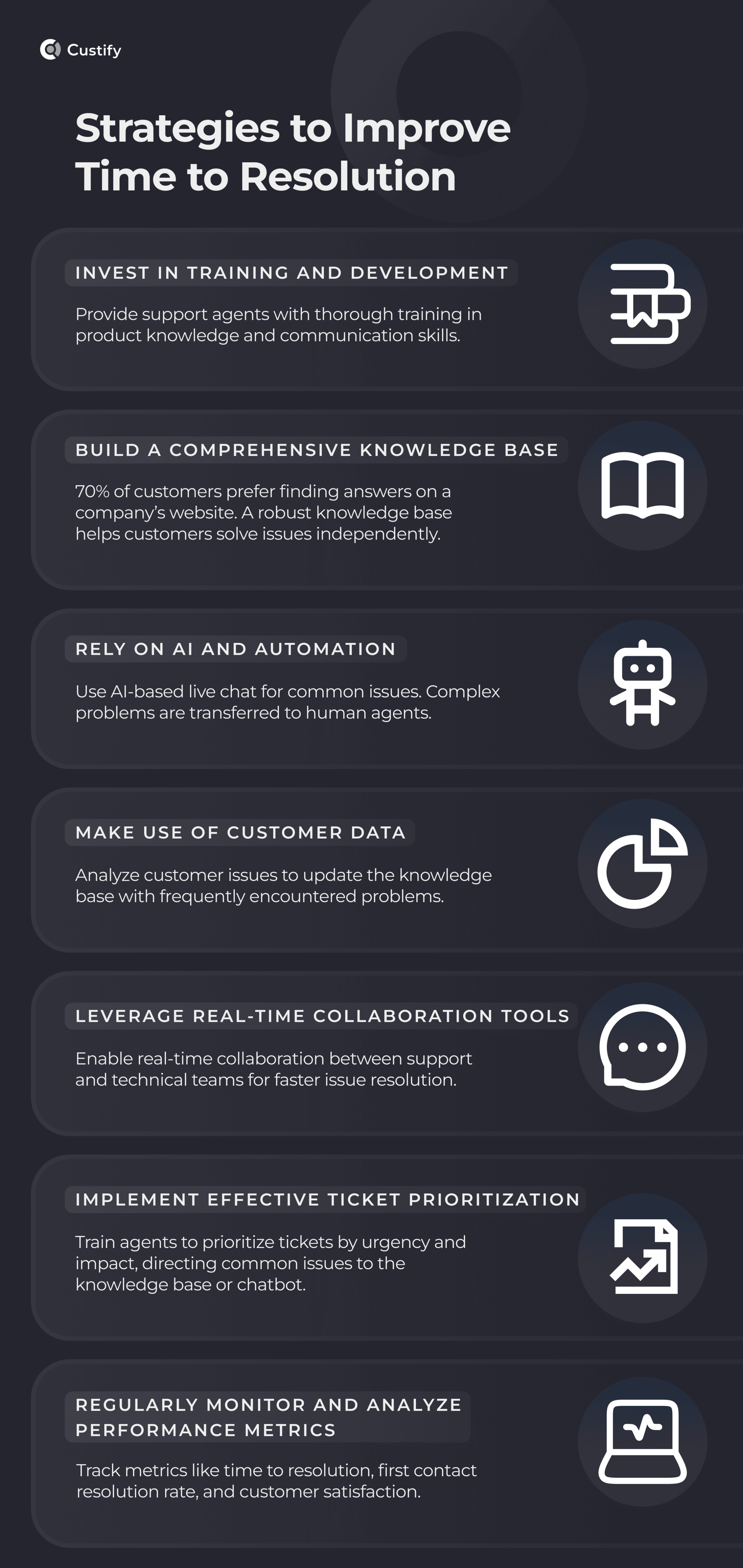A few minutes could make the difference between a happy customer and them moving to the competition. Why? Because the competition is fierce, especially in B2B SaaS. How can you make sure that you don’t lose customers? By solving their issues quickly and efficiently.
In this article, we are going to deep dive into one of the most important customer service metrics – Time to Resolution. You will learn:
- What is Time to Resolution and why it matters
- How to measure this metric
- Tactics to improve Time to Resolution
Let’s get started!
What is Time to Resolution?
Time to Resolution refers to the time it takes a customer service team to check and solve customers’ issues. This is a key metric for customer service because it highlights how quickly this department can resolve a customer problem, no matter if it’s a technical issue or a simple request.
Why is TTR important?
How important is this metric? When asked by Zendesk what are the aspects of a good customer service experience, over 60% of respondents highlighted “issue resolution”. Also, around 50% of respondents mentioned they would switch to a competitor after one poor experience. If they have more than one bad experience, 80% of customers would move to the competition.
Apart from being an important indicator of a good customer experience, solving customer queries effectively also has an impact on customer satisfaction and loyalty.
Why should you track time to resolution?
By tracking time to resolution you will be able to:
- Spot value of time: Time is important for both your business and your customer. If you manage to resolve issues quickly then you will have more satisfied and loyal customers.
- Measure customer experience: As mentioned, this is a great indicator of customer experience. If your customers have to jump through hoops to solve their pressing issues, then that’s not what we would call a great customer experience.
- Establish realistic SLAs: If you measure TTR, then you will be able to set out more realistic SLAs (Service Level Agreements) that align with your customer expectations while also having achievable timelines.
Measuring Time to Resolution
To measure Time to resolution you can calculate the recording of the start time and end time of each customer service conversation. Then, you should average it across all resolved requests.
Formula:

Here the total resolution time refers to how long it takes a customer service agent to resolve a request or a ticket from the moment the customer reaches out until the problem is completely resolved. Then, the number of resolved requests is the total number of cases successfully solved within a period of time.
For example, if your customer service team resolved 5 cases in 20 hours, then the average time to resolution is 4 hours.
Common issues in measuring TTR
There are a few common problems that can impact how you measure Time to Resolution. First off, your customer service team doesn’t work 24/7 so many hours are taken into account, even if the customer service reps can’t handle that request. This is why many tools provide Business hours or office hours so you can monitor only the hours in which your team is active and able to handle those customer issues.
Also, you might spot huge differences in TTR depending on the type of request. While some can be solved within minutes, others require a few business days and more teams involved. This type of situation can make it difficult for businesses to correctly measure TTR and create a sustainable benchmark.
Here are a few other things that can impact how you measure Time to Resolution:
- A few complicated customer situations are increasing your average TTR
To solve this problem, you should always exclude exceptions. If you observe that a case is taking a lot more than your average TTR, then you should investigate the situation and then exclude it from the measurement.
- Your team has completed the conversion, but the issue is not resolved
In this situation, make sure that all of your team members are using the same approach and know when a customer issue is actually resolved. Also, you can consider resolving conversations after a given time if the customer doesn’t reply in a certain timeframe.
- Customers reopen the same conversation for a different reason
You need to make sure that a conversation can’t be reopened once closed. If your customer service software doesn’t allow you to lock conversations once resolved, then you should exclude reopened conversations when you measure time to resolution.
TTR Benchmarks
It’s fairly hard to provide a benchmark for this metric. Why? Because it is influenced by many factors, including the industry, the matter of the issue, and the channel used by the customer to contact customer service.
Of course, customers expect you to solve their issues quickly and efficiently. A common benchmark for most industries is 24 hours. However, if we are talking about a tech problem that could stop your customer’s business it needs to be solved in 2-3 hours.
Here’s a table with the average time to resolution for each industry:
| Industry | ARG (hours) |
| IT Services & Consulting | 25.6 |
| Financial Service | 25 |
| Healthcare | 26 |
| Media & Telecommunications | 21.3 |
| Real Estate | 26.9 |
| Software | 21.9 |
| Web Applications | 22.1 |
| Marketing | 24.5 |
| Manufacturing | 28.5 |
Also, you will see that there are different expectations depending on the channel the customer used to contact your customer service department.
- Phone – 3-7 minutes: When a customer uses the phone to contact you, they require a quick resolution and a real-time interaction.
- Email – 24 hours: If your customer service team is reached via email, the customer might need to send detailed explanations and they are more understanding of the delay.
- Self-service – Instant: A knowledge base is the perfect way to allow customers to solve their issues in a matter of seconds without having to interact with the customer service team.
- Live chat – 10 minutes: This type of real-time engagement facilitates swift issue resolution.
- Social Media – Comments – 24 hours; Chat – 10 minutes: Comments offer detailed reporting with a longer response time; chat functions similarly to live chat, with quick responses expected.
Challenges and solutions for reducing TTR
How can you reduce time to resolution? Well, there are different strategies that you can apply. However, before we deep dive into concrete strategies, let’s take a look at some common challenges that once resolved can have a huge impact on TTR:
First Response Time is too slow
This common issue can be solved by implementing automated workflows to reduce the work of your customer service reps. Also, make sure that your triage process is in check.
Customers come back for more clarifications
If you observe a lot of back-and-forth in these conversations, you should make sure that your customer service reps anticipate follow-up questions. They should be able to provide more information before the customer comes back to ask for them.
Customers don’t share enough information
First off, take a look at your contact forms. Do you ask for all of the necessary information? Also, train your customer service reps to ask for details from the first conversation to make sure they have everything they need to solve the issue.
It takes a lot of time for other teams to resolve customer issues
Poor communication and collaboration issues between different departments or teams can negatively impact TTR. Offer your teams collaborative tools that are easy to use and make sure that the teams can easily communicate with each other.
Work is lost internally
If a situation doesn’t move from an internal team back to the customer service department, you should revisit the help desk setup.
Now that we discuss some of the most common challenges when it comes to reducing TTR, let’s take a look at some general strategies that can improve this metric.
Strategies to Improve Time to Resolution
To make sure that you solve your customers’ issues fast and in an effective manner, you could try out these strategies:
1. Invest in training and development
Equip support agents with thorough training and resources to handle queries efficiently. This includes both product knowledge and communication skills. Training and development programs have a huge impact on employee engagement and performance. Frontline workers often benefit the most from well-structured training programs. Understanding and improving employee engagement metrics is crucial for these employees, as highlighted in various studies that show notable improvements in satisfaction and performance. A study from Quantum Workplace shows that 79% of employees who had a formal development program were engaged.
2. Build a comprehensive knowledge base
A whooping percentage (70%) of customers prefer to use a company’s website to get answers to their questions rather than contact customer service via phone or email (Social Media Today).
This shows that people want to solve their issues alone, if possible. To avoid your customer service reps getting swamped with easy-to-solve issues, you should create a comprehensive knowledge base that will allow customers to search for solutions.
3. Rely on AI and automation
An AI-based live chat can also be a great option, especially if there are common, easy-to-solve, issues. Statistics show that 62% of respondents prefer engaging with customer service digital assistants rather than waiting for human agents.
A customer could find a way to solve their issue in a matter of minutes. If the problem is too complicated, then the chatbot can transfer the customer to a human agent.
4. Make use of customer data
When you check the issues that customers experience with your product you will notice that many of them experience the same problems. If this is the case, then you can include more information about those problems in the knowledge base.
5. Leverage real-time collaboration tools
Make sure that your teams collaborate with each other in real-time with the help of collaboration tools. For instance, if the customer experiences technical issues, the customer service agent should be able to contact technical support and collaborate with them to solve the customer’s problem faster.
6. Implement effective ticket prioritization
Train your customer service agents to prioritize tickets in an effective way. Urgent, impactful problems like technical issues should be solved first. Common issues should be redirected to the knowledge base or the chatbot, while other common problems can be solved in a few hours or days by customer service agents.
7. Regularly monitor and analyze performance metrics
Lastly, you should monitor time to resolution, first contact resolution rate, and customer satisfaction to make sure that your customers are happy and their problems are solved in a timely manner.

Time to resolution: Effectively solve your customers’ issues
In today’s fast-paced world, quick and effective customer support is crucial, and that’s where Time to Resolution (TTR) comes in. It’s all about resolving issues quickly to keep customers happy and loyal. We’ve covered how essential TTR is, how to measure it, and strategies to improve it, like investing in training, using automation, and leveraging customer data.
Improving your Time to Resolution (TTR) is a game-changer for delivering exceptional customer support. Remember, a happy customer is a loyal customer, and speedy, efficient support is a key ingredient in achieving that.




